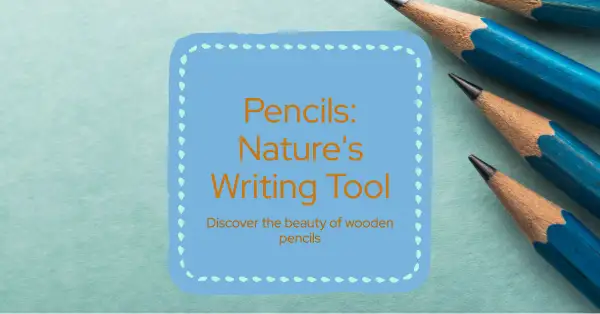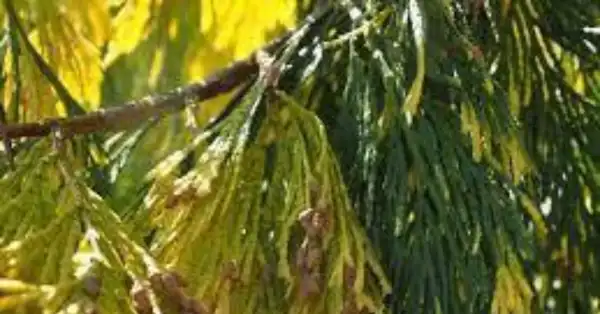Are Pencils Made of Wood?
Yes, pencils are made of wood. The most common wood used for pencils is cedar, which is a soft, strong, fine-grained wood without any knots that is easy to sharpen.
However, as supplies of cedar wood became scarcer, pencil manufacturers began using wood from at least 14 different types of trees to make pencils.
The wooden part of a pencil is made by cutting blocks of wood into slats that are machined to form a groove to place the lead.

The center of a wooden pencil is made from graphite encased in wood.
The Best Type of Wood for Making Pencils
Support us by using our links. We may earn a commission, but it won’t cost you extra. Win-win shopping
When it comes to making pencils, certain characteristics make a wood type ideal for the job. The wood needs to be strong enough to withstand the pressure of sharpening and writing, yet soft enough to create smooth and consistent lines. It should also be easy to sharpen and have a straight grain for optimal performance.
One of the most popular choices for pencil wood is Californian Incense Cedar.
This wood has been a traditional favorite for its excellent qualities. It is lightweight, easy to sharpen, and produces a smooth writing experience. The straight grain of Incense Cedar allows for precise sharpening and consistent lines.

However, there are alternative woods that can be used for making pencils. These options provide different characteristics and unique qualities.
Some examples include Basswood, which is known for its softness and straight grain, and Beech Wood, a common European hardwood that offers durability and strength.
Exploring different pencil material options allows for creativity and customization. Each wood type brings its own unique qualities to the pencil-making process, resulting in a variety of writing experiences.
14 Types of Wood Used to Make Pencils
In the world of pencil-making, there is a wide range of wood types used to create these beloved writing tools. Each wood brings its own unique characteristics and qualities to the pencil-making process, resulting in a variety of writing experiences.
Let’s explore some of the most popular types of wood used to make pencils:
- Abachi Wood: This African tropical hardwood is known for its lightness and durability, making it a great choice for pencils.
- Ayous Wood: Hailing from Africa, Ayous wood is versatile and easy to work with, making it a popular option for pencil production.
- Basswood: With its softness and straight grain, Basswood is a favorite among pencil manufacturers. It allows for smooth sharpening and consistent lines.
- Beech Wood: As a common European hardwood, Beech wood offers durability and strength, making it an excellent choice for high-quality pencils.
- Californian Incense Cedar Wood: This traditional favorite is lightweight, easy to sharpen, and produces a smooth writing experience. Its straight grain allows for precise sharpening and consistent lines.
- Caribbean Pine Wood: Known for its fast growth, Caribbean Pine wood is a sustainable option for pencil production.
- Eastern White Pine Wood: This straight-grained softwood is another popular choice for pencil-making, offering a smooth writing experience.
- Jelutong Wood: This controversial pencil material is soft and easy to carve, but its use is debated due to sustainability concerns.
- Poplar Wood: Extensively used in India, Poplar wood is lightweight and offers a smooth writing experience.
- Pulai Wood: Found in Southeast Asia, Pulai wood is a sustainable option for pencil production.
- Red Cedar Wood: A traditional pencil material, Red Cedar wood is known for its pleasant aroma and durability.
- Vatta Wood: Hailing from Indian Kerala, Vatta wood is a popular choice for pencil-making due to its strength and durability.
- White Fir Wood: An alternative to Incense Cedar, White Fir wood offers similar qualities and is used in pencil production.
- Weymouth Pine Wood: Used by Derwent Pencils, Weymouth Pine wood is known for its quality and performance.
These are just a few examples of the many types of wood used to make pencils. Each wood brings its own unique qualities, allowing for a diverse range of writing experiences.
Read: Are Pencils Biodegradable?
Frequently Asked Questions (FAQs)
How Many Pencils Can Be Made from One Tree?
A tree’s pencil yield varies based on size and pencil thickness, but it averages 2500-3000. Sustainability is a priority.
Why Are High-Quality Pencils Made from Cedar Wood?
High-quality pencils are often made from cedar wood, specifically Incense Cedar or Red Cedar. Cedar wood is chosen for its excellent qualities that enhance the writing experience. It has a straight grain, which allows for precise sharpening and consistent lines.
Cedar wood is also lightweight, making it easy to handle and sharpen.
Additionally, it has natural oils that give pencils made from cedar wood a pleasant aroma. These qualities, combined with the durability and strength of cedar wood, make it a preferred choice for high-quality pencils.
What Types of Wood Are Used for Pencils in the UK?
In the United Kingdom, pencil manufacturers use a variety of wood types for pencil production. Some common wood types used for pencils in the UK include Basswood, Beech wood, and White Fir wood.
Basswood is favored for its softness and straight grain, allowing for smooth sharpening and consistent lines. Beech wood offers durability and strength, making it suitable for high-quality pencils.
White Fir wood is an alternative to Incense Cedar and shares similar qualities, providing a smooth writing experience. These wood types are carefully selected to ensure the production of reliable and enjoyable pencils for consumers in the UK.
Conclusion
The choice of wood used in pencil manufacturing plays a crucial role in the quality and performance of the final product.
Wood Pencil manufacturers utilize various types of wood to create pencils with different characteristics. From the popular Incense Cedar and Red Cedar used in high-quality pencils to Basswood, Beech wood, and White Fir wood used in the UK, each wood type offers unique qualities that enhance the writing experience.
Whether it’s the straight grain of cedar wood for precise sharpening or the softness of Basswood for smooth lines, the diversity of pencil wood ensures there is a pencil suitable for every preference.
In conclusion, pencils are indeed made of wood, and the type of wood used greatly impacts the quality and performance of the pencil. By understanding the different wood options and considering environmental factors, you can make an informed choice when selecting the perfect pencil for your writing endeavors.
